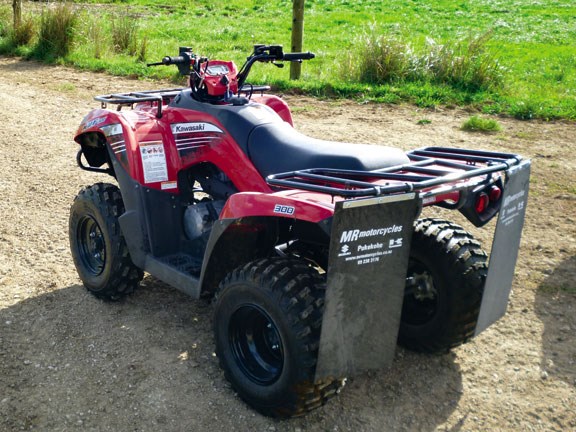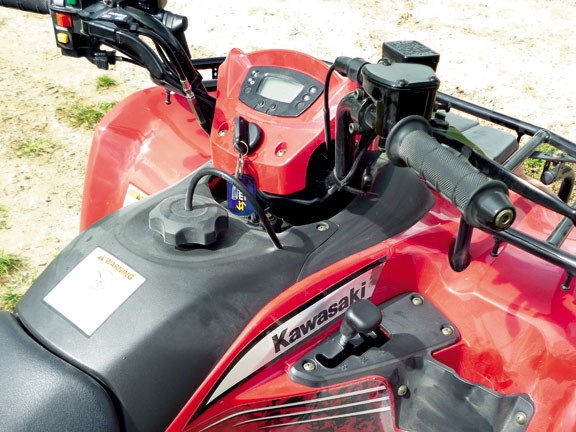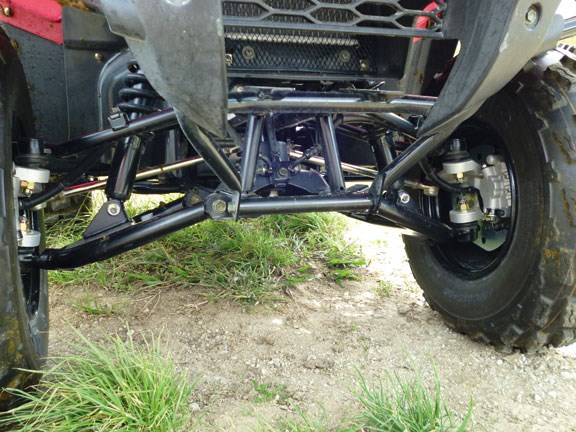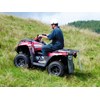Review: Kawasaki Brute Force 300 quad











|

|

|

|

|
After testing the Kawasaki Brute Force 650, Brent Lilley was keen to test its little brother – the low-cost Brute Force 300. For a cheaper option, the performance of this bike was nothing short of impressive.

|
|
Kawasaki Brute Force 300 quad
|
If you read my test last month, I hope you were just as impressed as I was with what the Kawasaki Brute Force 650 had to offer. For those of you that didn't rush out and buy one because you are looking for something smaller, then read on.
This month, I'm bringing you my findings from a test I carried out on the Kawasaki Brute Force 300. I was lucky enough to test it in Tapora, Northland, on the same day and under the same conditions, as the 650. It was very impressive to see that Kawasaki has included many of the features from the 650 on the 300 and it was also exciting to see that the smaller bike performed to a very high level in the same conditions as its big brother.
Once again, there were three local farmers on hand for the test drive, all pretty keen to give the 300 a good workout, as well as tell me what they really thought about it. The test once again took place on a brilliant, sunny northland day on a dairy farm managed by Robert Brookes who was kind enough to let us tear around his paddocks. . . . "as long as he could join in, too".
Engine
The quad has an impressive 271cc liquid-cooled single-cylinder four-stroke engine squeezed in under the seat, which has been tuned for low-end and mid-range power, while this engine doesn't compare to the massive outputs offered by a lot quads these days, that's not what this quad is about, in a bike of this size, with a very low weight, it provides plenty of power to get around in most situations. We tested the bike on some relatively steep hills where it had no problems at all getting to the top and on a flat farm race it had fairly impressive acceleration. The engine has a reliable electric starter, a back-up recoil starter for peace of mind, and a balancer for smoothness. I was very impressed to see that a bike with an engine of this size was also liquid cooled. The Kawasaki sticks with a tried and tested, reliable carburettor, which is fine on a bike of this size. The air intake is located up under the handle bars, out of the mud and dirt.
Transmission
The transmission on this bike is the real surprise. Most bikes of this size and price range stick to a manual five speed transmission, but not Kawasaki, which has used a continuously variable transmission similar to that found in the larger Brute Force models that runs through a centrifugal clutch. The transmission features Hi, Lo, Neutral and reverse, and can be selected with a shift lever located under the handle bars on the right hand side.
This transmission setup works well and is great to see the 650s included on this bike. In Hi gear, the bike has a good speed range for getting around the farm quickly or following cows down the race, and a fairly good top speed to get down the road. When we got on to the steeper hills, Lo gear definitely gave a lot more control when going up or down. This was where one of the few things I disliked about this bike became apparent, while the engine braking on the bike works well, when going downhill the centrifugal clutch does not engage unless the throttle is pressed. So if you stop on a hill, then go to move off again, the bike will start to free wheel until you accelerate to engage the clutch, then the engine braking will slow the bike down. This all takes some getting used to, as human nature has you taking your thumb off the throttle when a bike starts going too fast.
Chassis
The bike sits in a sturdy, well-balanced chassis that is built out of high-tensile tube steel. At the front of the chassis, double wishbone suspension is used to mount the front wheels, and adjustable independent struts give a smooth ride and good control of the bike.
The bike feels like a decent sized quad when you're riding it, however most agreed that the ride was not as comfortable as what the bigger quads offer, but again, that's not what this bike is about. Dual single-piston disc brakes are fitted out near the wheels on each. At the rear of the bike there is a solid bar axel that is mounted to the frame by a tube steel swing arm that uses a single adjustable shock for the rear suspension. There is a single disc brake on the drive shaft to the rear axle.
Layout and controls
As mentioned, it's great to see a liquid-cooled engine on a quad bike this size. The radiator is mounted up the front, but the filler and level is cleverly mounted towards the rear under the seat, which is great, the level can be checked with a sight that can be seen from looking under the mudguard or topped up by simply removing the seat. This is something I liked about the Brute Force bikes, as on other bikes the radiator level and filler are under the front carrier, which can be very hard to access once anything is mounted on there. A 12-litre fuel tank with a reserve is situated up in front of the seat. Under the front carry there is a decent sized sealed storage compartment which is good to see, although if anything is fixed to the front carrier then this compartment will become inaccessible.
The layout of the controls on the bike is pretty much standard, on the right hand side the throttle and a brake lever are up on the handle bars. The gear shift and a handy cup/bottle holder is moulded in the plastic body work under the handle bars. In the centre is the key and a digital display with a speedometer, trip meter, fuel and temperature gauges, a clock, and neutral, reverse and high beam indicators. There is also a handy 12 volt power socket included here on the bike. On the left hand side, on the handle bars are the lights, starter, engine kill switch, choke, a reverse override switch and a brake lever. The park lock is on this side as well, but unlike many other bikes that use a little clip or such to lock the brake lever, the Kawasaki uses a completely separate lever that mechanically locks the rear brake separate from the hydraulic brake system. This is an excellent idea and the lever can be operated with one hand.
Verdict
The Brute Force 300 was probably the bike I was most interested to check out as I knew the price that Kawasaki was selling them for, so was keen to see exactly what you got and how it preformed - to say the least, I was fairly impressed by it. The transmission really is a huge positive for this bike, although the problem with the bike free-wheeling if the throttle is not pressed to engage the centrifugal clutch is a little unnerving, this is a problem that is shared by many ATVs and UTVs on the market. Many other features such as the liquid cooled engine and the disc brakes all round, won't be found on other bikes in this class at this price.
This bike also opened my eyes to a market that sometimes gets forgotten, many farm owners and people who have had a lot of experience on bikes sometimes forget that when they first started riding quad bikes, a 250 or 300cc bike was the biggest on the market and that's what they learnt on, letting new staff with little experience loose on a 750cc quad is the same as letting someone on a learner licence loose in a V8 Supercar - it's going to end in tears.
Manufacturer says
The Kawasaki Brute Force 300 has been designed to include many features from the bigger quads, while still retaining the entry level price and functionality of a 300cc quad. It has been built with the same quality that is seen across the Kawasaki range and comes with a standard two-year warranty.
Here in New Zealand, the bike is being marketed to take back a share of the market that quad bikes have been priced out of. Kawasaki believes that it is a great bike for riders that are new to quads and people who just want a simple quad to get themselves, a few tools and maybe the dog around the farm at a very affordable price. Farmers are now looking for good quality at a good price and that is what the Kawasaki Brute Force 300 has to offer.
Positives
- Automatic CVT transmission
- Liquid-cooled engine with easy access filler and level
- Easy to use mechanical hand brake lever
- Price - exceptional value for the features on this bike
- Hydraulic disc brakes all round
Negatives
- Will free-wheel down a hill if the throttle is not engaged
- Would like to see a park lock on bikes with an automatic transmission
- The suspension on this bike could be better when riding over rough terrain.
For the latest reviews, subscribe to our Farm Trader magazine here.
Keep up to date in the industry by signing up to Farm Trader's free newsletter or liking us on Facebook



.jpg)



.jpg)
.jpg)
.jpg)

